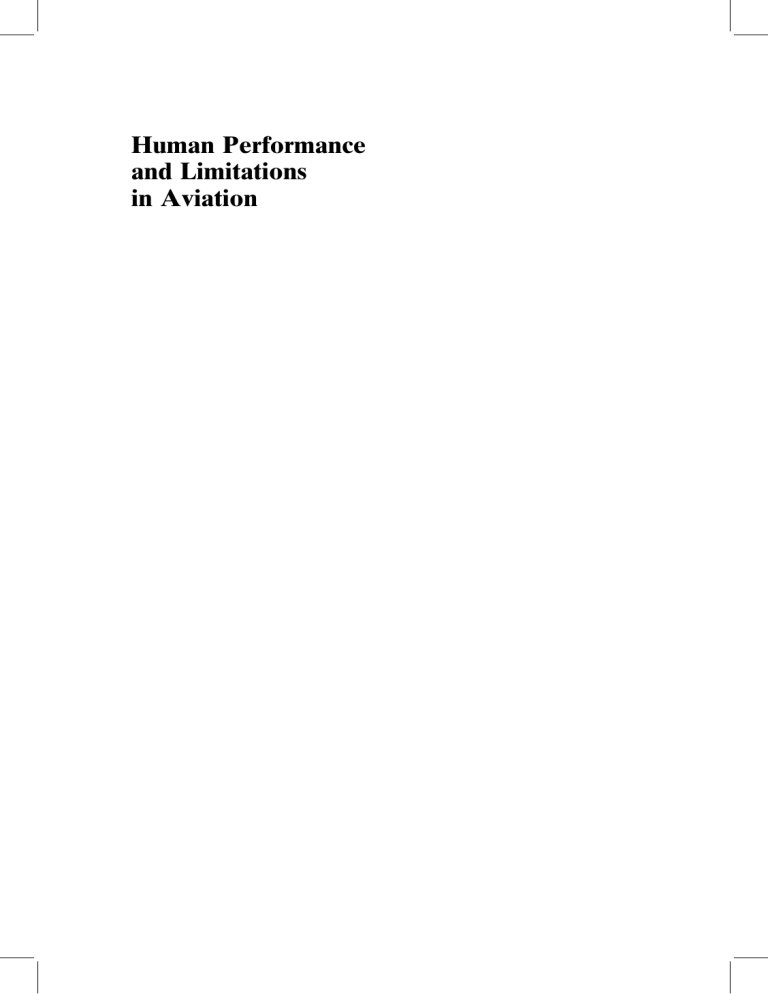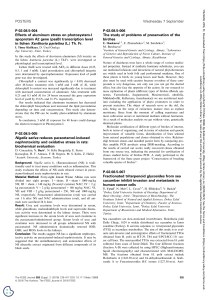Human Performance and Limitations in Aviation - 2002 - Campbell - Frontmatter
advertisement

Human Performance and Limitations in Aviation in Aviation Third edition R.D. Campbell MBE, DFC, AFC, FRAeS, MBAC and MB, BCh, MRCS, LRCP, MFOM, DAvMed, DFFP, FRAeS Blackwell Science 10.1002/9780470774472.fmatter, Downloaded from https://onlinelibrary.wiley.com/doi/10.1002/9780470774472.fmatter, Wiley Online Library on [20/11/2023]. See the Terms and Conditions (https://onlinelibrary.wiley.com/terms-and-conditions) on Wiley Online Library for rules of use; OA articles are governed by the applicable Creative Commons License Human Performance and Limitations M. Bagshaw b Blackwell Science Ltd Editorial Offices: Osney Mead, Oxford OX2 0EL 25 John Street, London WC1N 2BS 23 Ainslie Place, Edinburgh EH3 6AJ 350 Main Street, Malden MA 02148 5018, USA 54 University Street, Carlton Victoria 3053, Australia 10, rue Casimir Delavigne 75006 Paris, France Other Editorial Offices: Blackwell Wissenschafts-Verlag GmbH KurfuÈrstendamm 57 10707 Berlin, Germany Blackwell Science KK MG Kodenmacho Building 7±10 Kodenmacho Nihombashi Chuo-ku, Tokyo 104, Japan Iowa State University Press A Blackwell Science Company 2121 S. State Avenue Ames, Iowa 50014-8300, USA The right of the Author to be identified as the Author of this Work has been asserted in accordance with the Copyright, Designs and Patents Act 1988. All rights reserved. No part of this publication may be reproduced, stored in a retrieval system, or transmitted, in any form or by any means, electronic, mechanical, photocopying, recording or otherwise, except as permitted by the UK Copyright, Designs and Patents Act 1988, without the prior permission of the publisher. First Edition published 1991 Reprinted 1992, 1993, 1994, 1996 Second Edition published 2001 Third Edition published 2002 Set in 10.5/13.5 Times by DP Photosetting, Aylesbury, Bucks Printed and bound in Great Britain by MPG Books Ltd, Bodmin, Cornwall The Blackwell Science logo is a trade mark of Blackwell Science Ltd, registered at the United Kingdom Trade Marks Registry DISTRIBUTORS Marston Book Services Ltd PO Box 269 Abingdon Oxon OX14 4YN (Orders: Tel: 01235 465500 Fax: 01235 465555) USA and Canada Iowa State University Press A Blackwell Science Company 2121 S. State Avenue Ames, Iowa 50014-8300 (Orders: Tel: 800-862-6657 Fax: 515-292-3348 Web www.isupress.com email: orders@isupress.com Australia Blackwell Science Pty Ltd 54 University Street Carlton, Victoria 3053 (Orders: Tel: 03 9347 0300 Fax: 03 9347 5001) A catalogue record for this title is available from the British Library ISBN 0-632-05965-6 Library of Congress Cataloging-in-Publication Data Campbell, R.D. Human performance and limitations in aviation/ R.D. Campbell and M. Bagshaw.Ð3rd ed. p. cm. Includes bibliographical references and index. ISBN 0-632-05965-6 1. AeronauticsÐHuman factors. I. Bagshaw, M. (Michael) II. Title. TL553.6 .C35 2001 629.132'52Ðdc21 2001037960 For further information on Blackwell Science, visit our website: www.blackwell-science.com 10.1002/9780470774472.fmatter, Downloaded from https://onlinelibrary.wiley.com/doi/10.1002/9780470774472.fmatter, Wiley Online Library on [20/11/2023]. See the Terms and Conditions (https://onlinelibrary.wiley.com/terms-and-conditions) on Wiley Online Library for rules of use; OA articles are governed by the applicable Creative Commons License # R.D. Campbell and M. Bagshaw 1991; the estate of R.D. Campbell and M. Bagshaw, 1999, 2002 Preface Part 1 1 1.1 1.2 1.3 1.4 ix Human Factors: Basic Concepts Human Factors in Aviation Competence and limitations Becoming a competent pilot Accident statistics Flight safety concepts Part 2 Basic Aviation Physiology and Health Maintenance 2 The Basics of Flight Physiology 2.1 The atmosphere Composition Altitude The physical gas laws 2.2 The respiratory and circulation systems Functional anatomy The hypobaric environment Hypoxia Oxygen systems Cabin pressurisation Rapid decompression Decompression sickness Barotrauma Hyperventilation Effects of acceleration 2.3 The high altitude environment Ozone Cosmic radiation Relative humidity 3 Man and the Environment: The Sensory System 3.1 The central and peripheral nervous system Central nervous system 1 3 3 5 6 7 9 11 11 11 12 13 15 15 19 21 26 27 27 28 29 30 31 33 34 35 37 39 39 39 v 10.1002/9780470774472.fmatter, Downloaded from https://onlinelibrary.wiley.com/doi/10.1002/9780470774472.fmatter, Wiley Online Library on [20/11/2023]. See the Terms and Conditions (https://onlinelibrary.wiley.com/terms-and-conditions) on Wiley Online Library for rules of use; OA articles are governed by the applicable Creative Commons License Contents 3.2 3.3 3.4 3.5 4 4.1 4.2 4.3 4.4 Peripheral nervous system The autonomic nervous (vegetative) system Workings of the nervous system Vision Functional anatomy of the eye The visual field ± scanning techniques Binocular and monocular vision Night vision Hearing Functional anatomy of the ear Flight related hazards to hearing Effects of altitude change Equilibrium Functional anatomy of the vestibular system Motion sickness Integration of sensory inputs Orientation Sensory illusions and spatial disorientation Vestibular illusions Visual illusions Approach and landing errors Prevention of disorientation Health and Hygiene Personal hygiene Common minor ailments Colds Influenza Gastro-intestinal upset Problem areas for pilot health Hearing loss Defective vision Hypotension Hypertension Coronary artery disease Obesity Nutrition Tropical climates and epidemic disease Intoxication Tobacco Alcohol Drugs and self-medication 39 40 40 42 42 46 49 51 52 52 53 54 55 55 57 60 60 60 61 63 64 67 69 69 69 70 71 71 72 72 74 77 78 79 80 81 83 86 86 87 90 10.1002/9780470774472.fmatter, Downloaded from https://onlinelibrary.wiley.com/doi/10.1002/9780470774472.fmatter, Wiley Online Library on [20/11/2023]. See the Terms and Conditions (https://onlinelibrary.wiley.com/terms-and-conditions) on Wiley Online Library for rules of use; OA articles are governed by the applicable Creative Commons License vi Contents Toxic hazards Carbon monoxide 4.5 Incapacitation during flight Symptoms and causes Operational coping procedures Flying after SCUBA diving Part 3 5 5.1 5.2 5.3 5.4 6 6.1 6.2 6.3 6.4 7 7.1 8 8.1 8.2 Basic Aviation Psychology Human Information Processing Attention and vigilance Perception Perception illusions Perceptual subjectivity Memory Short-term memory (sensory) Long-term memory Working memory Motor memory (skills) Response selection Learning principles and techniques Motivation Human Error and Reliability Reliability of human behaviour Hypotheses of reality Theory and model of human error Error generation Ergonomics Economics Social environment Decision Making Decision-making concepts Structure phases Limits Risk assessment Practical application of risk management Avoiding and Managing Errors: Cockpit Management Error management Safety awareness Risk area awareness Error proneness vii 93 94 95 95 97 97 99 101 103 104 105 106 106 107 108 109 110 110 110 114 116 117 118 119 119 120 123 124 125 126 126 126 127 129 132 132 133 133 134 10.1002/9780470774472.fmatter, Downloaded from https://onlinelibrary.wiley.com/doi/10.1002/9780470774472.fmatter, Wiley Online Library on [20/11/2023]. See the Terms and Conditions (https://onlinelibrary.wiley.com/terms-and-conditions) on Wiley Online Library for rules of use; OA articles are governed by the applicable Creative Commons License Contents Contents 8.3 8.4 8.5 9 9.1 9.2 10 10.1 10.2 10.3 11 11.1 11.2 11.3 Error sources Situational awareness Multi-crew co-ordination Co-operation Group dynamics Leadership and management styles Individual duty and role Advantages and disadvantages of team work Communication Communication models Verbal and non-verbal communication Communication barriers Conflict management Personality Personality and attitudes Development Environmental influences Individual differences in personality Human Overload and Underload Arousal Stress Stressors Stress overload Anxiety and its relationship to stress Effects of stress Stress management Coping strategies Sleep and fatigue Stages of sleep Performance and alertness Management of fatigue Preventative measures Advanced Cockpit Automation Advantages and disadvantages Advantages Disadvantages Automation complacency Working concepts In Conclusion Bibliography Index 135 136 136 138 138 140 141 142 142 143 146 147 147 149 149 150 151 151 157 157 158 161 164 165 165 167 168 170 171 172 174 175 178 181 181 181 183 184 186 187 188 10.1002/9780470774472.fmatter, Downloaded from https://onlinelibrary.wiley.com/doi/10.1002/9780470774472.fmatter, Wiley Online Library on [20/11/2023]. See the Terms and Conditions (https://onlinelibrary.wiley.com/terms-and-conditions) on Wiley Online Library for rules of use; OA articles are governed by the applicable Creative Commons License viii Travel by air is a relatively safe means of transport, and there has been a great improvement in the accident rate since 1960. This is due to enhancements in technology, manufacturing standards, maintenance, operational procedures and training. However, human error continues to be cited as a major cause in over 70% of aviation accidents. It is widely agreed that a better understanding of human capabilities and limitations, both physical and psychological, could contribute to a reduction in human error and improve flight safety. The first edition of this manual was published in 1991 to provide a readable introduction to the basic concepts of human factors in aviation. There was recognition of a particular need for the enhancement of judgement and decision making, particularly amongst private pilots, and the manual was aimed at increasing the necessary knowledge. In 1992 the UK Civil Aviation Authority introduced an examination in Human Performance and Limitations for applicants for all private and professional pilot licences. In Europe, the Joint Aviation Authorities have published the Joint Aviation Requirements for Flight Crew Licensing (JAR-FCL 1) which was adopted in 1996 and implemented 1 July 1999. Subpart J details the syllabus for the Human Performance and Limitations examination and this manual has been completely revised and rewritten to encompass the syllabus requirements. The opportunity has been taken to remove some information which, although of interest to pilots, is not a requirement for the JAR-FCL examination and is readily available from other sources (e.g. the chapter on first aid). The coverage of basic aviation psychology has been greatly expanded although, continuing the principle of the first edition, consciously avoiding the use of excessive ix 10.1002/9780470774472.fmatter, Downloaded from https://onlinelibrary.wiley.com/doi/10.1002/9780470774472.fmatter, Wiley Online Library on [20/11/2023]. See the Terms and Conditions (https://onlinelibrary.wiley.com/terms-and-conditions) on Wiley Online Library for rules of use; OA articles are governed by the applicable Creative Commons License Preface Preface jargon and technical language. The basic aviation physiology section now includes topics on the high altitude environment and on health maintenance. Ron Campbell died in 1996. The first edition of this manual evolved from his belief in the importance of teaching judgement and decision making in flying training. It is a privilege to continue his vision in the preparation and production of this third edition. Since preparation of the second edition of this manual in April 1999, the JAA have expanded the knowledge requirement of applicants for professional pilot licences. Also, training in Multi Crew Co-operation (MCC) is now a mandatory requirement for gaining a JAA Air Transport Pilot Licence (ATPL), and this manual covers the syllabus for the human factors module. It also provides material for training in Crew Resource Management (CRM) and for Simulated Flight Instructor (SFI) core courses. Although this manual encompasses the syllabus requirement for flight crew licensing, the original objective of covering the basic concepts of human factors in aviation remains unchanged. Aviation is truly international and this easy-to-read manual will be of interest and value to all aviation professionals, medical practitioners and human factors specialists world-wide. I am grateful for the assistance of Laurie Benn and Brian Johnston of the Department of Civil Aviation Studies, London Guildhall University, in ensuring that this manual continues to meet the requirements of subpart J of JAR-FCL 1. However, any errors or omissions are mine. Michael Bagshaw September 2001 10.1002/9780470774472.fmatter, Downloaded from https://onlinelibrary.wiley.com/doi/10.1002/9780470774472.fmatter, Wiley Online Library on [20/11/2023]. See the Terms and Conditions (https://onlinelibrary.wiley.com/terms-and-conditions) on Wiley Online Library for rules of use; OA articles are governed by the applicable Creative Commons License x
